It appears the relationship between farmer, miller and baker is somewhat broken and I feel this relationship should be intrinsically bound. Reading last night the book Dan Lepard recommended to me a month ago, Breads White And Brown – Their Place In History, by R A McCance and E M Widdowson, the author mentions in early times how grinding and bolting (sieving) was carried out under the direction of the baker. McCane writes, the Latin word for baker is pistor which means pounder or grinder. Three weeks ago I sat at a table with a miller and farmer and while sitting there between them as the baker I could see how this linear link is disjointed.

At present in the best of circumstances there will be a good relationship between farmer and miller with the farmer wanting to grow the wheat to the best possible standards in order for the miller to accept it after the harvest. The farmer’s involvement stops there, his criteria of moisture, gluten percentages and falling numbers have all been checked and approve by his client, invoices raised and the delightful sight of an empty barn has been fulfilled.
Now a new relationship begins between miller and baker, the milling to be carried out in accordance to the baker’s demands and his method of baking. This relationship even a excellent one seems to be the less integrated of the trio and when analysing it I find this odd since a loaf is 100% flour (baker’s percentages), without the flour there is no bread. Jean-Philippe de Tonnac the author of Dictionnaire Universel du Pain made a poignant observation when I was discussing the difficulties in finding out what’s in flour from millers, “..for years we have accepted the flour from mills without any questions asked, and things have got to this bad state, we can only blame ourselves for acting like children”.
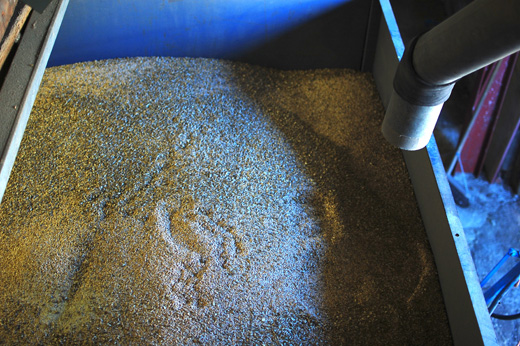
Millers tell me they develop flour characteristics working alongside bakers to produce a flour suitable to their style of baking like that used in Artisan Bakery. I must stress here I have no idea what Artisan Baking actually is, you see the more I find out about the bread baking world the less I know what that title stands for. I used to think artisan baking stood for far more than just an alternative to the Chorleywood process, that it stood for old methods of baking using sponge/biga/poolish/pre-ferment whatever you want to call it, it stood for long fermented doughs allowing the enzymes to breakdown the wheat and transforming the resulting crumb and enabling the development of bacteria contributing to the overall flavour of the loaf as well as digestibility. If artisan baking is about these methods of baking then the flour still being used comes into question.
Let me tell you the story of what happen to me this week because I think it highlights everything that is odd between the relationship of the miller and the baker. I was asked a few weeks ago to test some roller white flour by a well known mill, one that has been around for many years and many generations, going by their reputation from various people it’s said they produce some of the best flour in this country. Great! I love nothing more than opening a new pack of flour and start playing. As soon as the specifications of the three different types of flour arrived this week I picked one to bake. It was easy to chose out of a Canadian, an organic, and a finest flour because both the Canadian and the organic had amylase enzyme added.
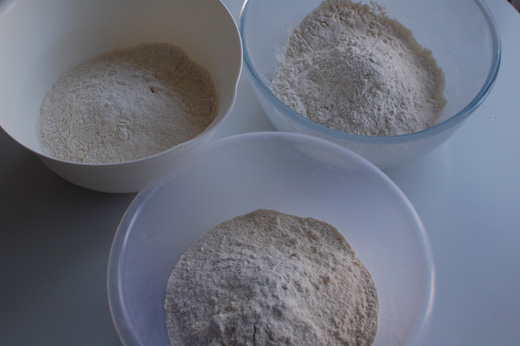
I’ve said on here before and still do I don’t have a problem with amylase being added, I don’t buy into the scaremongery on this subject. I would like to read research carried out, one which is properly published and out there to be scrutinised by others in the field, at that point I will be happy to drive the bandwagon if necessary. I’m too old now and have become too cynical being bombarded with so many half-arsed researches being publicised scaring me into not eating anything.
My problem with added amylase is as a baker, why it’s there and what it’s trying to compensate for. In my last post on this subject here, I explain how it produces a horrible mouth-feel, a wet-wool gummy crumb. Added amylase is there to provide moisture and lasting shelf-life in a quick turn around process. Artisan baking with slow fermented yeast dough and sourdough already do that naturally, the process gives the enzymes in the flour time to carry out their work. I realise this natural process will never match the long shelf-life of an artificially enhanced loaf but that’s fine. I would also like to add here even in my quick-turn-round loaf I wouldn’t chose flour with added amylase because gummy crumb doesn’t feel right.
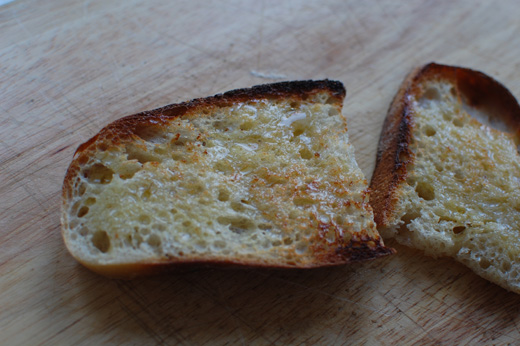
Back to my story, I picked the finest flour with nothing added, and as soon as I finished mixing the dough it didn’t feel right and I wish I could find words to describe it. When handling different flours your hands will let you know when the dough doesn’t feel right, and this white flour created a dough with a strange sticky wet feel but not actually wet, the dough wasn’t left on my hands it stretched and sprung back onto itself in a gloppy movement. This flour has 13.2% protein. I shaped the loaf and left it overnight for last rise at room temperature and proved well near its limit but still performing as you would expect. The loaf was as disappointing as the dough, I gave the first slice to Bikerboy, he looked at me quietly chewing waiting for me to speak first, when I said it’s not very nice is it? He replied, “thank god you said that I didn’t want to say anything in case you thought I was criticising your baking”.
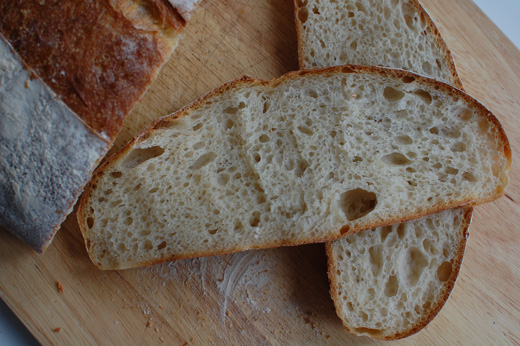
The problem with this loaf was the horrible chewiness of the crumb and the lack of crust formation. I describe bread with incredible chewiness as having a chewing-gum crumb, the chewing goes on and on and you’re never rid of this over masticated crumb. If you were to eat the bread with ham or cheese they would be long swallowed and you’d still be trying to be rid of the bread. Very glutenous flour also produces a poor crust, if you want to know how to make a good crust follow the example of a good French baker.
I rang the person at the mill telling them why I wasn’t going to post about their flour, I didn’t like it and didn’t think it suited this type of baking. I was asked to expand on why and while giving them detailed feedback I kept being interrupted by their marketing speech on how wonderful their flour was, how sorry they were I didn’t like it but how they supplied it to all sorts of bakeries including many Artisan bakeries, how they work in a close relationship with the bakers to develop flours suitable for them and how great they find their flour. As soon as I start hearing marketing speech trumpeted out there’s a switch in me that goes off. If you can’t take feedback when asking for it don’t ask, that’s all I’m saying.
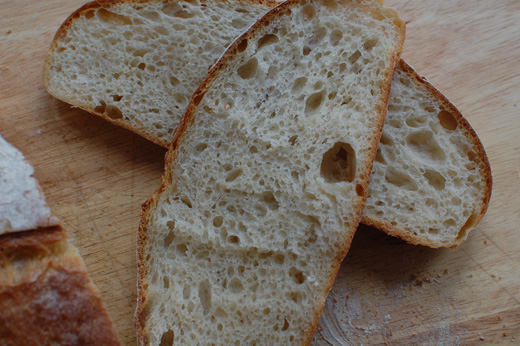
Flour with added enzymes, or in the case with the fine flour which is over-selected with gluten performing proteins in its blend, are over-engineered for creating an Artisan loaf in my opinion. The Chorleywood process works with enhancers, improvers, enzymes but who are these Artisan bakeries taking in this flour and why? What special relationship is this between miller and baker that drives enzymes to be added to your flour, even organic ones? I’m not putting myself on some moral pedestal here, my kids eat supermarket bread sometimes and you only have to see the smiley eyes of allergy kid when eating a slice of supermarket white to know I haven’t won her away from supersoft gummy bread.

Going back to the beginning of this post when I was sitting at the table with the farmer and the miller, these were good people who each cared deeply about their individual part in the process to produce their product, low input farming and stone milling using local grown wheat, but neither of them baked nor did they show signs of being interested in the end result of their products; the loaf. It appears odd that the baker who’s the receiver of this labour turning it into his perfect loaf is not engaged in the whole process, to be there from the beginning of developing varieties.

Rolland Feuillas Mill
I’ve listened to millers that do bake and who are fastidious in getting the milling right to achieve optimum results for the bread. I have also met the likes of John Letts who’s a farmer and miller and Roland Feuillas who’s a farmer, miller and baker, who see the loaf as a consolidated process. I’m not suggesting bakers become famers or millers, a good busy baker already works long unsociable hours. Nope let’s be real, I’m merely pointing out the obvious of how things have become and we arrived here a long time before the Chorleywood process, this goes back to the time we started forming large towns and cities.
If Artisan baking is to disassociate itself from this process I feel the place it could start is in the relationship of farmer, miller and baker. In some Artisan bakeries there is a good relationship with the miller and with the provenance of the grain but why isn’t there a relationship with the farmer?
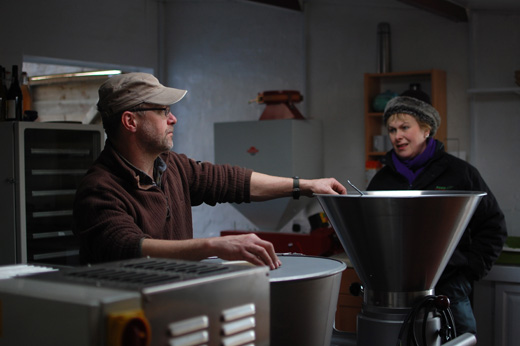
John Letts
Things are complicated because we are not just talking about one farmer supplying one flour. Mills make a blend based on their criteria, they’ll gather different grains, some British some from other countries and work out their grist, their secret recipe for their perfect flour. The miller is making all the decisions the way I see it in this process, by picking and choosing which varieties they buy in from different farmers, co-ops and grain merchants, often dictated by the needs of plant bakeries and their machines. The Artisan baker may perceive he has a choice in this “close working relationship” the miller speaks of, but does he? Does the Artisan baker really have a choice? It’s like saying to me you can have a dress made in any pattern, in any material and any colour you like….and here is my limited choice for you to chose from.
More choice doesn’t equate to better flour, flour is far more complicated, protein percentages are not all equal, two 12% protein flours will behave differently and there’s other considerations as well. Roland and John will use one white wheat flour based on their mixed wheat varieties grown in the field and their flour makes good bread so choice is not necessarily better. I wanted to highlight how the relationship between the end user, the baker is so far removed from the grower, the farmer. Shouldn’t we be taking more steps to make the bridge in that relationship shorter? We will always import some wheat and the control over that will have limitations but for the wheat we grow here why isn’t the farmer more part of the process with the baker? Why does the miller have nearly all the say in the process?



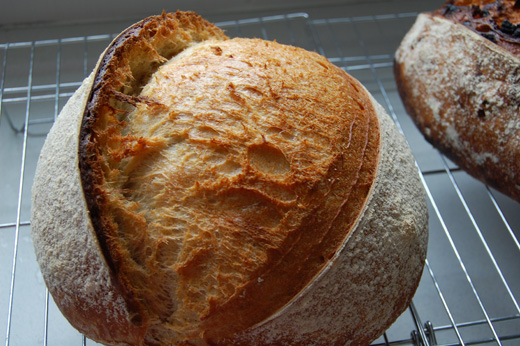

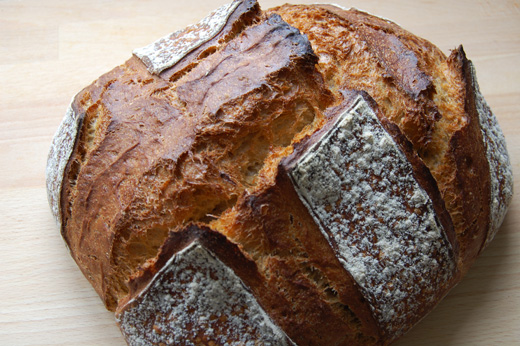



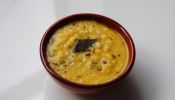


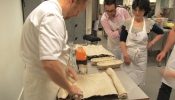

















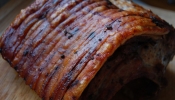



{ 7 comments… read them below or add one }
Azélia,
Great read (amazing blog). I am pretty sure that “pistor” means “miller” as well as “baker”, which I guess indicates the bakers used to mill their own flour. xxx from Lisbon.
just spent a weekend at Rye Windmill B & B in East Sussex, and in the lounge, under the mill, the old wood fired bread ovens…and in the Town Hall entrance, a wooden cart from ‘The Mill Bakery’…how times have changed….
Azelia, your blog is extraordinarily good. Please keep great posts like this coming. Thank you.
Thanks Gary & Daniel
Azelia, I couldn’t agree more. I have baked almost every day this year on a tireless journey of learning and discovery. While I wish I had your talent for creating clarity, in my own way, I too have come to realise that there is something seriously wrong with flour for the artisan baker. I want the best organic, locally grown, stone milled flour and sadly this is not working out. I am not necessarily saying freshly milled flour is better, but I can tell the difference in the handling as it ages. So buying fresh from my local water mill or something from the internet, Bacheldre, Gilchesters, Fosters might be months old and quite different, not to mention the dizzying variations in what they think is white (forget asking for the extraction rate, because even if they think they know, there is NO consistency between batches!). Many mills blend imported wheat with home grown and even add gluten to make up the numbers. Since organic is important for me, forgive me about being just a bit sceptical about organic standards in Kazakhstan. And as you have said the obsession with gluten is not shared by artisans who can actually make bread by hand.
So I have made two decisions recently. Firstly I am ditching all wheat for spelt and secondly I am buying a grain mill! I still need white spelt and Doves have assured me their spelt is either British or German and though roller milled, it has nothing at all added. Then I’ll buy Alkor spelt from Hammond’s End and their rye and make my own wholemeal flour. At least then I’ll know exactly how old the wholemeal flour is and the white flour is more stable to store anyway.
If you like I’ll let you how I get on, but in the meantime, do look into grain mills. There is a widespread culture of this in Germany with beautifully crated mills in every size from table top to massive industrial ones. Bakery Bits have a new range!
Take Care
Aniko
Azelia
You blog is fantastic. Thank you. I appreciate what you are saying about the disconnect between farmers, millers and bakers. At Organic Arable we are trying to do something about that. We are working with Hammonds End Farm (a member) and supplying Howard with wheat from other of our farmers.
I believe the reason for the disconnect is convoluted supply chains and the obfuscation that merchants make money from. As a producer focused business our interest is developing the market for our producers rather than increasing our margin. We believe in transparency and an understanding within the supply chain that everyone has to be mutually benefited from the relationship. This takes effort and time and costs money which is why we charge the commission we do. However this is fixed and is known to all parties and so regardless of the prices involved everyone knows where they stand. It is a simple convept but one that can work.
Enough waffle. I’d be very interested to understand how big the demand for single variety flours from home bakers is. We can get the wheat grown, milled and sold if there is the demand. However realistically we probably need to know that what scale of demand there is. No point in growing 50 tonnes of wheat for a 5 tonne market. Your thoughts and comments would be most welcome.
Keep up the blogging.
Andrew – the feeling and experienced I’ve had is that there is very little understanding in how to deal with single varieties grown in this country by bakers because they have been indoctrinated with the mixed flour blend to do whatever recipe they throw at it, I explain in my post here http://www.azeliaskitchen.net/blog/baking-by-numbers-thats-what-bakers-do/.
Isn’t it a catch22? In order for people to demand they have to be introduced and shown how to use it but also why they should use it, and that in turn will create more demand. In my book I’m going to make reference to single varieties and how to bring the best out of them, I think if people could get their heads around mixing their own blends at home rather than at the mill they can discover great flavours in varieties.